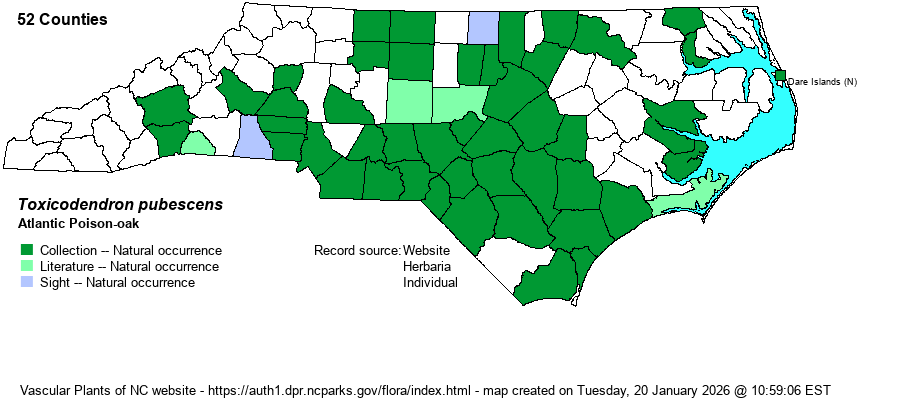| Author | P. Miller | |
| Distribution | Occurs nearly throughout the Coastal Plain and Piedmont, but scarce in the southern Mountains, only at lower elevations. Range maps are likely incomplete for this and the other two Toxicodendron species due to hesitancy of biologists to collect plants for fear of contact dermatitis. Relatively few county records for the eastern Coastal Plain, where suitable habitat (dry/upland forests) is more limited than farther inland and to the south.
This is a Southern species ranging north only to NJ and southeastern KS, and south to central FL and central TX.
| |
| Abundance | Common and widespread in the Sandhills; fairly common to common elsewhere in the southern half of the Coastal Plain. Fairly common in the eastern Piedmont, but infrequent in much of the western and central Piedmont and northern Coastal Plain. Rare in the Mountains. | |
| Habitat | This is a species of dry soil, mostly in open woods, such as pine-oak sandhills and rather xeric Piedmont woods. In the Piedmont, it can also be found around granitic flatrocks. It does not occur in moist or rich soils, unlike Poison-ivy (T. radicans). |
| Phenology | Blooms in late April and May, and fruits from August to October. | |
| Identification | This is a deciduous shrub, typically only 1-2 feet tall, and often growing in colonies. The leaves consist of three similar-shaped leaflets, rather shiny above, and broadly lobed, as in a leaf of Chestnut Oak (Quercus montana), for example. Each leaflet is about 3 inches long, and each has a stalk, especially the middle/end leaflet. Fragrant Sumac (Rhus aromatica) has its middle leaflet tapering to the base and essentially without a stalk. Poison-ivy leaflets are typically quite jagged-edged, with sharper serrations; the leaves typically are thinner than those of Poison-oak. Of course, Poison-ivy also can be a vine that grows high into trees, but it also can form knee-high shrubby colonies, just as Poison-oak does. Both species have small yellow flowers and waxy white rounded “berries”. Though this species contains urushiol, as do Poison-ivy and Poison Sumac (T. vernix), it is not overly potent, and many people who are susceptible to Poison-ivy do not contact dermatitis after (at least casual) contact with Poison-oak. Nonetheless, it is best to identify the species without touching it! | |
| Taxonomic Comments | The taxon has traditionally been named as Rhus toxicodendron, but these three species have since been moved to Toxicodendron. Some references name it as T. toxicodendron. As Weakley (2018) states: “The nomenclatural confusion may still not be resolved.” A few older references may have considered this species as a variety or ecotype of T. radicans; RAB (1968) states: “This may be only varietally different from no. 2 [Poison-ivy], possibly an ecotype”.
| |
| Other Common Name(s) | Poison-oak (or Poison Oak). Though typically known simply as “Poison-oak” in the Southeast, there is a species of Toxicodendron in the western states, named as Western Poison-oak. Thus, a modifier name for the eastern taxon is warranted. | |
| State Rank | S5 | |
| Global Rank | G5 | |
| State Status | | |
| US Status | | |
| USACE-agcp | FACU link |
| USACE-emp | FACU link |

